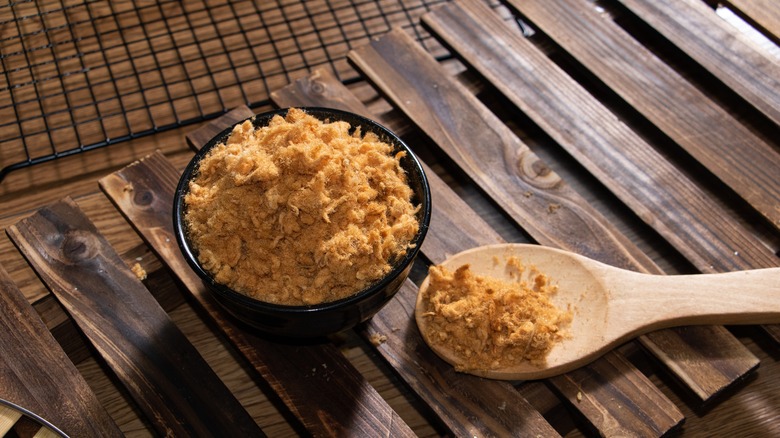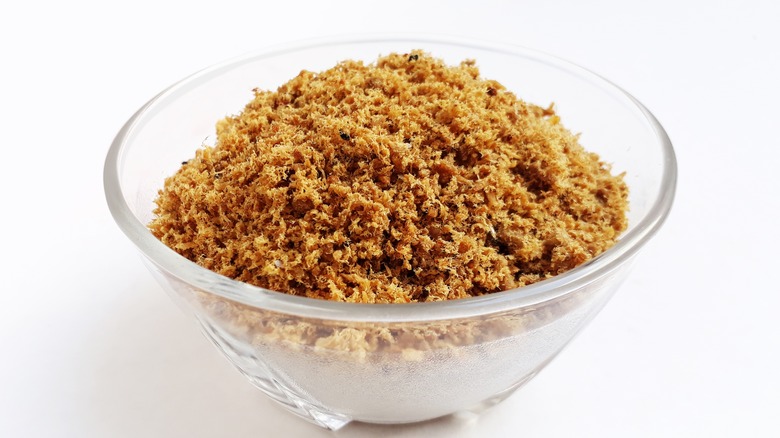Every time we find and learn about a new ingredient we haven’t cooked with before, we can’t help but get excited. Not only does learning about these ingredients help us try new things, it also helps us come up with new ways to use our favorite ingredients to make food taste better. This time around, that ingredient is pork floss.
Pork floss is the dream for anyone who has ever wanted to eat savory cotton candy. Seriously, if your mouth didnt water at that, we would be amazed. The ingredient used to be tucked away in the back of our Asian market, but lately it’s become very popular thanks to social media sites like TikTok, where one user said it made “fluffy jerky” taste great. We looked into this Asian ingredient and found the best ways for you to use it in your own kitchen.
Pork sung, also known as pork floss or rousong, is a popular Chinese condiment made from dried, shredded pork. With its sweet umami flavor and fluffy texture, pork sung can elevate many savory dishes. But some wonder if regularly eating pork sung may be bad for health due to its high sodium content and heavy processing. Here’s a look at the nutrition profile, benefits, downsides, and overall health effects of this Asian topping.
What is Pork Sung?
Pork sung starts by slowly stewing fatty pork cuts like belly or shoulder until extremely tender. The meat is then shredded into fine fibers and dried out, resulting in a light, cotton-like texture. It’s often seasoned with soy sauce, shaoxing wine, sesame oil, and spices.
The finished pork sung provides a sweet and salty umami burst of flavor. It can be used as a condiment sprinkled on items like congee, buns, and noodles. Pork sung also frequently appears as a filling for dumplings or component for fried rice.
Nutrition Profile of Pork Sung
A 1 ounce (28 gram) serving of pork sung provides approximately
- Calories: 90
- Protein: 8 grams
- Fat: 4 grams
- Carbohydrates: 2 grams
- Sodium: 330 mg
So pork sung offers a good amount of protein, plus some fat. However, the sodium content is high, providing 14% of the recommended daily limit.
Potential Benefits of Eating Pork Sung
Here are some of the main advantages associated with consuming pork sung
-
Protein – Made from pork, it provides an easy source of protein to support muscle growth and maintenance.
-
Flavor – Pork sung adds delicious umami depth with its savory, slightly sweet taste. This may boost appetite and enjoyment of foods.
-
Convenience – Shelf-stable and lightweight, pork sung is an easy way to incorporate flavor on-the-go for snacks, backpacking meals, etc.
-
Versatility – It can quickly elevate the flavor of many types of dishes, from Asian congee to Western omelets.
When used in moderation, pork sung can be a tasty addition to a balanced diet.
Potential Downsides of Eating Pork Sung
However, there are also some drawbacks to consider regarding regularly consuming pork sung:
-
Sodium – The 330 mg of sodium per serving is high, especially for those restricting salt intake due to conditions like hypertension.
-
Lacks nutrients – Beyond protein, pork sung doesn’t provide much additional nutritional value compared to fresh pork.
-
Heavily processed – Shredding, drying, and seasoning make pork sung a heavily processed food. Some research links frequent processed meat intake to health risks.
-
Food safety – Pork sung could harbor harmful bacteria if not properly stored sealed and refrigerated.
While small amounts are likely fine for most, eating pork sung regularly may be problematic. Moderation and proper storage are key.
Is Pork Sung Healthy Overall?
Can pork sung be part of a healthy diet? In moderation, pork sung is unlikely to pose major health risks for most people. It offers the benefit of easy protein and lots of flavor.
However, those limiting sodium due to high blood pressure or heart issues should be mindful of portion sizes of high-sodium pork sung. It may be best to balance out its saltiness by pairing pork sung with fresh vegetables, fruits, and whole grains.
Rather than making pork sung a dietary staple, incorporate a variety of lean proteins like fish, beans, nuts, eggs, and poultry. Eating an array of minimally processed foods will provide more nutritional benefits. But enjoying some pork sung occasionally can fit into an overall nutritious lifestyle.
Tips for Using Pork Sung
When cooking with pork sung, keep these tips in mind:
- Sprinkle on top of congee, fried rice, noodles, and Buddha bowls
- Use in place of bacon on baked potatoes or scrambled eggs
- Mix into dips, mashed potatoes, mac and cheese, or stuffings
- Top pizza, flatbreads, and tacos for a flavor boost
- Stuff into dumplings, egg rolls, spring rolls, and buns
- Garnish Asian-style sandwiches instead of deli meats
Balance out the sodium in pork sung by eating it alongside plenty of fruits and veggies. Moderating portion size is key, even more so for those requiring a low-sodium diet. Properly storing opened packages of pork sung in the fridge helps maximize safety.
The Bottom Line
Overall, occasional pork sung consumption can be part of a healthy diet for most people. In moderation, it provides protein and lots of flavor. But regularly eating large amounts may increase sodium and processed meat intake more than recommended. Those with specific dietary restrictions should be especially mindful of portion sizes of high-sodium pork sung. When used as a flavor-boosting garnish and balanced with fresh produce, pork sung can be a tasty addition to many dishes.

How do you store pork floss?

If you want your homemade or store-bought pork floss to stay fresh for as long as possible, you need to store it correctly. The best way to make homemade pork floss last as long as possible is to cook off as much of the extra water as you can and let the meat cool before putting it on the top of the container. Otherwise, condensation can build inside of the container and cause your protein to spoil or mold faster. Once it’s cool, put it in a container that won’t let air in. This will keep moisture out, and then put it somewhere dry, cool, and out of direct sunlight. You could also vacuum seal the food to make it last even longer, but not every home cook has the right tools on hand.
Before using your pork floss, look for any obvious signs of mold and discoloration. Also, when you take the pork floss out of the jar, you should use clean, dry tools so that no water or bacteria can get in and ruin the condiment.
Can you make floss with other meats?

There are different kinds of dried meat floss, not just pork floss. Products made from other proteins are also similar. The same spices are used to make chicken floss and pork floss. Chicken floss is made with skinless chicken breasts. As expected, this chicken product doesn’t have as much umami flavor and richness as the pork product. In Malaysia, beef floss is a popular source of protein. You can also make it by boiling a big piece of low-fat beef and adding a mix of chiles and spices to make its flavor stronger. These meat alternatives are good for people with different diets and food tastes, so they can be used in more dishes and cultures.
In recent years, there has also been a push to make fish and shrimp floss in ways that aren’t usually used. Another Malaysian food is serunding ikan, which is made by cooking a fish called threadfin bream with aromatics and spices until it has the consistency of floss. Other creative cooks have found ways to use sliced textured vegetable protein, which is made from soy, to make plant-based floss.
WE Shorts – Formosa Brand Pork Sung w/ BlumGum & Trippy Food
FAQ
Is pork Sung good for you?
Is pork belly good or bad for you?
Is pork fat good or bad for you?
What is the difference between pork fu and pork sung?
Is pork bad for You?
High levels of carnosine have also been linked to lower fatigue and higher muscle performance in humans. While pork is rich in several important vitamins and nutrients, it can also be high in sodium and saturated fats, two things that should be avoided as part of a healthy diet.
Why is pork not recommended to eat?
This is not true, some cuts like sirloin and pork rump steak, for example, are very healthy, even healthier than beef and chicken. Only the fattest cuts like bacon and crackling should be avoided.
Is pork good for You?
Pork is a rich source of certain vitamins and minerals your body needs to function, like iron and zinc. It’s also an excellent source of high-quality protein. Minimally processed, lean, fully-cooked pork eaten in moderation can provide certain benefits when added to your diet.
What happens if you eat undercooked pork?
Eating undercooked or raw pork can result in parasitic infections. Taenia solium, or pork tapeworm, is an intestinal parasite. Most of the time it’s harmless, but it can occasionally cause a disease called cysticercosis, which leads to epilepsy.
